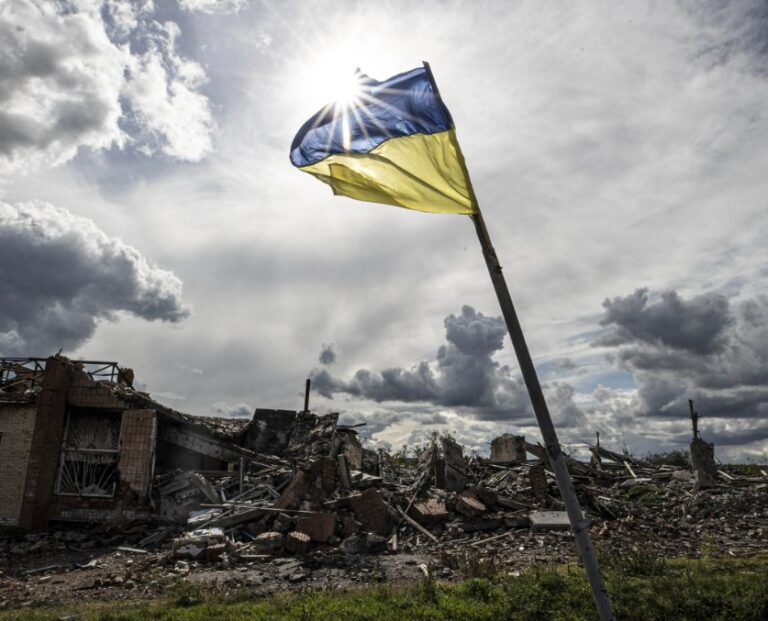On the night between Feb. 23 and 24 a year ago, the world learned that Vladimir Putin’s Russia had unleashed a large-scale invasion into Ukraine.
Since then, 12 months of death, destruction, atrocities and escalation have passed. And of that war – renamed at first “special military operation” in the Kremlin’s neolanguage – no end is in sight.
Table of Contents
The ancient reasons behind the Russian-Ukrainian conflict
The war in Ukraine that broke out on February 24, 2022, has ancient origins. The conflict between Russia and Ukraine has been going on since Ukraine’s independence in 1991.
At that point, the country was literally split in half, with a Catholic and pro-European West and a pro-Russian East, culminating in the two self-proclaimed republics in the Donbass: Donetsk and Luhansk. There, Russian is still spoken as the first language.
The crisis is ancient, then: but what are the motivations behind Putin’s invasion one year ago? Here are the main causes that led to the outbreak of war according to experts:
1. The breakup of the “three Slavic sisters”
Russia, Belarus, and Ukraine have been referred to as the three Slavic sisters. Three states, in short, very similar to each other, closely related even at the level of state-to-state family ties.
With the fall of the Soviet Union in 1991, the states formally separated, but Russia continues to want to bring the two nations back under its orbit.
2. Ukraine’s pro-European positions
The second point of friction between Moscow and Kiev concerns Ukraine’s openness to Europe. In 2014 occurred what has gone down in history as Euromaidan, the Revolution of Dignity, after pro-Russian President Viktor Yanukovich suspended the free trade agreement between Ukraine and the EU.
From there, the process of impeaching the president began and an interim government was established with pro-European Oleksandr Turcinov, who was never recognized by Moscow. In May, Petro Poroshenko was elected, and in 2019 the current president Volodymyr Zelensky.
Ukraine’s proximity to Europe never sat well with Moscow, which felt threatened by Ukraine’s opening to the West.
3. The Donbass issue
Russia’s response to Ukrainian protests has been the invasion of Crimea and subsequent Russian support for the uprising of pro-Russian separatists in the Donbass, where two independent republics have been declared.
The fighting, despite the fact that a cease-fire has long since been declared, has never stopped.
4. Ukraine’s possible annexation to NATO
Since World War II, Ukraine has played the role of a buffer state. A state, in essence, maintaining tactical neutrality between two superpowers to avert possible conflict.
But since independence in 1991 Ukraine has shown several signs of a willingness to move closer to NATO. If annexation has not yet taken place, it is only because NATO cannot accept the entry of states that still have unresolved conflicts within themselves.
The possibility of having a neighboring state being part of NATO, however, was enough to alarm Russia and make it perceive the threat of unwelcome Western expansion into Russian geopolitical sphere of influence.
War in Ukraine: the month-by-month timeline of the conflict
On February 24, 2022, Russia invaded Ukraine. A year of war, in which tens of thousands of people have died, has overheated the climate with Moscow isolated from its Western allies. Here are the key milestones month by month:
- FEBRUARY 2022: Russia invades Ukraine
It is the night of the 23rd to the 24th when, a few minutes before 5 a.m., Russian President Vladimir Putin announces the start of “a special military operation” to “demilitarize and denazify” Ukraine. It is the beginning of war. Ukrainian President Volodymyr Zelensky refuses to flee Kiev, calling for international support and weapons. The EU imposes its first sanctions. Ukraine applies for EU membership on Feb. 28.
- MARCH: the siege of Mariupol, the capture of Kherson, the attack to Zaporizhzhya
The month begins with the siege of Mariupol, a city on the Azov Sea with Ukraine’s most important port. March 3rd Russia announces the capture of Kherson and the next day attacks Zaporizhzhya, site of Europe’s largest nuclear power plant. On the 16th the Russians bomb a theater in Mariupol, killing at least 300 civilians, but their goal of reaching the capital in short order fails.
- APRIL: the massacre of Bucha, the siege of Azvostal
On April 2 Russian forces abandon Bucha, a town northwest of Kiev, leaving behind evidence of a full-scale massacre, with 400 bodies strewn across streets and mass graves. The Kremlin denies targeting civilians. On April 8, the massacre in front of the Kramatorsk train station: 52 dead, mangled by cluster bombs. On 21 Putin announces the seizure of Mariupol: 2,500 Ukrainian soldiers remain barricaded in the Azvostal steel plant, which has become a symbol of the siege.
- MAY: the fall of Mariupol, Finland and Sweden apply to join NATO
As the last soldiers leave the Azovstal steelworks, Mariupol falls on April 21 but the battle for Severodonetsk in Lugansk begins. On the 28th the Ukrainian counteroffensive on Kherson begins. The month ends with Biden deciding to send Himars to Kiev. Meanwhile, Finland and Sweden apply to join NATO.
- JUNE: EU grants Ukraine candidate status to enter the Union
On the 16th, French President Emmanuel Macron, German Chancellor Olaf Scholz and then-Council President Mario Draghi visit Kiev. Then, on the 23rd the EU grants Ukraine candidate status. On the 29th, NATO leaders formalize an invitation to Sweden and Finland to join the alliance. On the ground, Russia conquers Severodonetsk.
- JULY: the grain exports deal and the cut of gas supplies
Kiev and Moscow sign an agreement to resume grain exports from Ukraine. Soon after, Moscow attacks the port of Odessa and Gazprom cuts supply to Europe via the Nord Stream.
- AUGUST: Ukrainian offensive to regain Kherson
Kiev launches offensive to retake Kherson, while the battle for the eastern city of Bakhmut begins.
- SEPTEMBER: the Ukrainian counteroffensive, the mobilization of Russian reservists
Ukrainians recapture hundreds of towns in a counteroffensive around Kharkiv. Putin launches a mobilization of 300,000 reservists, triggering an exodus of young Russians of military age. Two explosions damage the Nord Stream on the 27th.
- OCTOBER: explosion of the Crimean bridge, Russian attack on Ukraine’s energy plants
On the 8th the bridge connecting Crimea to the Russian mainland, a symbol of Moscow’s annexation of the peninsula, is severely damaged. Russian forces respond with a flurry of attacks on Ukraine’s energy infrastructure, leaving millions without electricity.
- NOVEMBER: Russian withdraw from Kherson, two missiles falls in Poland
On November 9, the Russians withdraw from Kherson. Worldwide escalation is threatened when, in Poland, two missiles fall on the border with Ukraine, killing two people. NATO promises to admit Kiev into the Atlantic Alliance.
- DECEMBER: Zelensky meets Biden in Washington
The month begins with the ninth package of EU sanctions on Moscow. On the 22nd Zelensky goes to Washington on his first foreign trip since the war began: “Ukraine will never be alone,” Biden says before promising to send Patriot systems. And from Moscow, Putin responds with an announcement about the Sarmats.
- JANUARY 2023: Western tanks delivery to Ukraine
On New Year’s Eve, Russia suffers its largest troop loss since the invasion began: 89 soldiers are killed in the attack on Makiivka. January is also the month of the Western tanks delivery to Ukraine: Germany agrees to supply Kiev with Leopard 2s, the U.S. announces 31 M1 Abrams, and London promises Challengers. On Jan. 25, Ukraine admits retreat from Soledar, near Bakhmut.
- FEBRUARY: Western armaments to Ukraine, Putin threatens with nuclear arsenal
On Feb. 8, 2023, Prime Minister Rishi Sunak announces that the UK is considering sending long-range missiles and fighter planes to Kiev while Zelensky insists on an increasing supply of weapons, asking for fighter jets. But on the request the allies stall. Meanwhile, Putin’s delivers several nuclear threats to Ukraine and the West.
The war scenario: Russian counteroffensive in spring, threat of nuclear attacks and involvement of the West
According to Ukrainian intelligence, Putin has a definite plan to continue advancing east of Ukraine. The war will not end anytime soon, but by March it could be a heavy attack by Moscow’s troops.
Speaking to the Kiyv Post is Andriy Yusov, a representative of the Main Intelligence Directorate of Ukraine’s Defense Ministry. Yusov said that Kiev is aware of the air assets that Moscow might use to launch an offensive in Donetsk and Lugansk.
Ukraine will not be unprepared in March, the estimated month of the alleged Russian attack, as it can count on the Himars precision-guided missile system that has been provided by Western allies to the Ukrainian military.
Nevertheless, Kiev is still asking for military aid. Ukraine’s fear is that Putin may change strategy. For almost a year the war has been on the ground, with infantry troops and heavy vehicles. Since the infantry strategy caused huge losses, Putin and his generals might opt for a battle in the Ukrainian skies. In this case, Kiev could be prepared defensively, but could hardly lead an air counterattack against Moscow.
Adding to the fear of an air battle is the fear of a naval battle and nuclear war. Just a few days ago, on Feb. 15, 2023, Vladimir Putin authorized the sailing of the notorious Northern Fleet in the Baltic Sea to threaten countries such as Sweden, Norway, and Finland.
The Northern Fleet ships are equipped with nuclear weapons, and the fear that the war could cross Ukrainian borders and become global is becoming more and more concrete.
Read also: Russo-Ukrainian war, one year later: the number of military and civilian deaths and injuries












